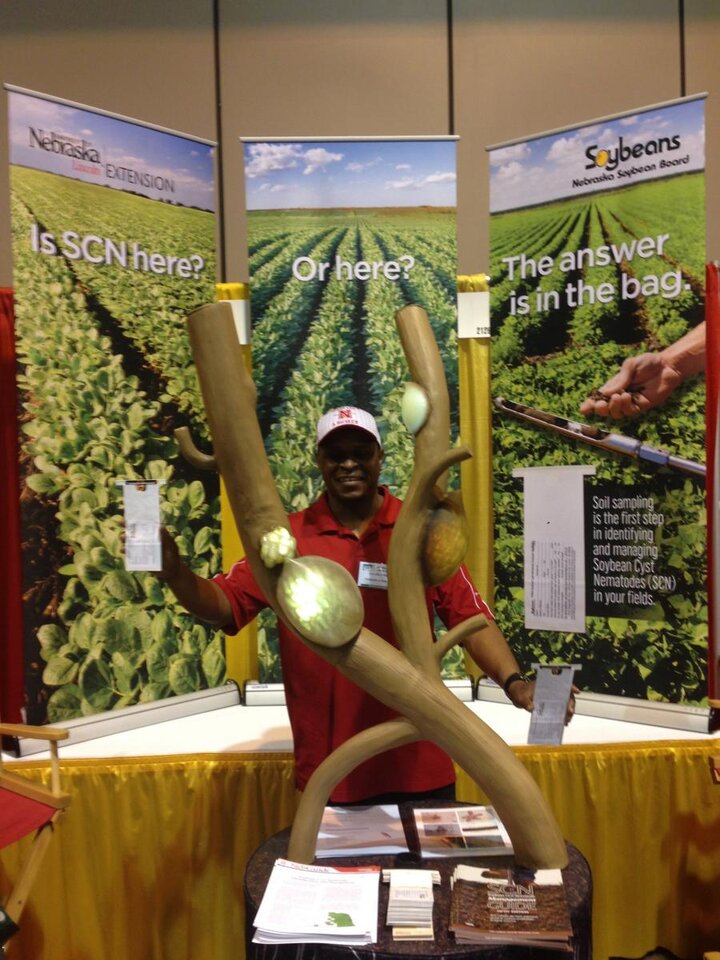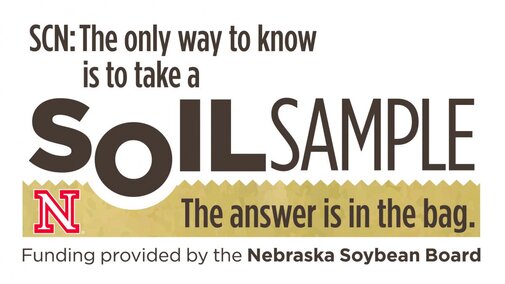The easiest and least expensive way to improve profitability for many soybean growers in tight economic times, or any time, is to sample fields for soybean cyst nematodes (SCN).
In over 8,200 soil samples processed by the University of Nebraska-Lincoln Plant Pathology Department since 2005, about a third have been positive for SCN. Last year this number approached 40%.
In the majority of the positive samples, the soybean farmers submitting the samples had no idea SCN was present in their fields. Fields can have 20%-30% yield losses with no visible signs on the plants, which appear dark green and healthy. In 29 replicated trials conducted in the eastern third of Nebraska, SCN-resistant varieties out-yielded top yielding SCN-susceptible varieties by an average of six bushels per acre.
Think about what an additional six bushels per acre of soybeans would have meant to your bottom line last year. And at little or no cost to you.
The cost of analyzing a soil sample for SCN is $20 at the University of Nebraska and may be that or a little more at commercial labs. However, the Nebraska Soybean Board sponsors a program to cover the cost of soil analysis for SCN for Nebraska soybean growers. This is a return from your soybean checkoff dollars on your farm.
One of the easiest times to sample your fields for SCN is when you sample for fertilizer recommendations. Just pull a few more soil cores when you, your field scout, crop consultant, or co-op sample the fields. Mix all the soil sample cores together and submit half for your fertilizer recommendations and half for SCN analysis.
If your sample comes back positive for SCN, you can start managing it by rotating soybeans with a non-host crop such as corn, sorghum, small grains, alfalfa, or just about any other crop grown in Nebraska. Then, in years when soybeans are planted, select for SCN resistance along with other important traits such as emergence, lodging, or disease resistance.

In Nebraska trials growers realized an average six-bushel-per-acre soybean yield increase after taking no-cost steps to manage soybean cyst nematode.

Almost all seed companies have several SCN-resistant varieties to select from and they sell for the same price as comparable susceptible varieties. Also, for those concerned about GMOs, SCN resistance is accomplished through a normal breeding program.
In the UNL trials planting a resistant variety provided an average additional return of six bushels per acre. Even though the yield response varied from field to field, in every trial the rate of SCN reproduction was reduced where SCN-resistant varieties were planted compared to where SCN-susceptible varieties were planted. However, the number of SCN eggs in 100 ccs of soil (enough soil to fill a pop can about one-third full) were counted in every plot in every trial at the beginning of the season and again at the end of the season. Even if farmers don’t see a big yield response, they will lower the pressure from SCN the next time soybeans are planted in that field.
Managing the egg density (number of eggs) is the key to managing SCN. By testing fields now, hopefully growers can catch an SCN infestation when the egg counts are low and keep them low. This is much easier than allowing SCN to build up and then try to bring high numbers down.
If fields were tested in the past and the results came back negative, continue to test for SCN about every six years to see if it has been introduced. Even if SCN did become established since the last test (anything that moves soil can move SCN), in this length of time the counts should still be at very manageable levels.
If past tests were positive for SCN, continue to sample every six years to see if egg counts are decreasing. It is important to sample at the same time of year and following the same crop as when the original sample was taken. By comparing egg counts, you can determine if your management practices for SCN were successful in reducing egg counts.
When SCN Resistance Falters
Sometimes test results show higher SCN egg counts when a field is retested six or seven years after the initial SCN detection or the last time the field was sampled for SCN, even after rotating with non-host crops and using SCN-resistant varieties. This often indicates the SCN population can reproduce on PI88788, the resistance source used in about 98% of commercially available SCN-resistant varieties. This resistance source is most common because it is the easiest one to breed in while maintaining yields.
SCN populations with virulence to this source of resistance are becoming more common in Nebraska. Almost half (47%) of 118 Nebraska SCN populations tested for virulence to different sources of resistance showed an ability to reproduce on PI88788. Other Midwest states have shown an even higher incidence of SCN populations with virulence to PI88788 varieties (Missouri – 78%; Illinois – 70%; Kansas – 64%; and Indiana – 56%).
You don’t have to quit using PI88788 resistant varieties altogether, but if you find this happening in your field, consider using a different source of resistance at least one or two times soybeans are planted in this field. Although other sources of resistance exist, you will probably be looking for a variety with Peking resistance (PI548402) which is the second most common source of resistance on commercially available SCN-resistant soybean varieties.
More Information
For more information on SCN identification and management, or for bags to submit soil samples for your free SCN analysis, contact your local Nebraska Extension office.

